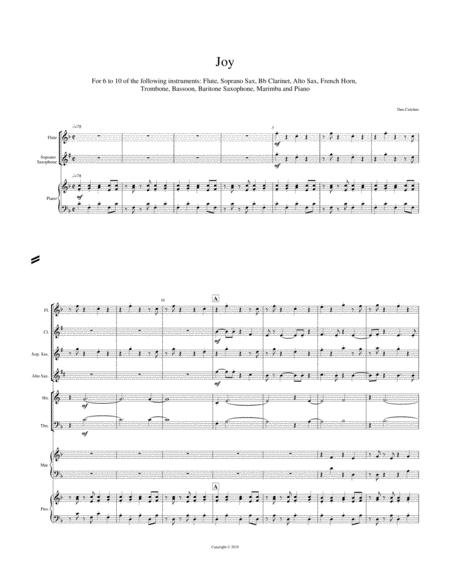Large Ensemble Alto Saxophone,Baritone Saxophone,Clarinet,Flute,Horn,Marimba,Piano Accompaniment,Soprano Saxophone,Trombone - Level 3 - Digital Download SKU: A0.844263 Composed by Dan Cutchen and Dan Cutchen. 20th Century,Contemporary,World. Score and parts. 54 pages. Dan Cutchen Music #2920627. Published by Dan Cutchen Music (A0.844263). For 4 to 8 of the following instruments: Flute, Soprano Sax, Bb Clarinet, Alto Sax, French Horn, Trombone, Bassoon, Baritone Saxophone PLUS, Marimba and Piano.https://www.youtube.com/watch?v=Sio4HdW28x4&feature=youtu.beSuggested arrangements of instrumentation (all parts are included in purchase, plus score):1. All 10 parts. 2. Flute, Bb Clarinet, Bassoon, Horn, Marimba, Piano. 3. Soprano Sax, Alto Sax, Bari Sax, Trombone, Marimba, PianoTime: Approximately 6:42The title came from the piece being dedicated to the composer’s wife. This composition reminded the composer of her delightful and kind character and her amazing and creative aptitude for organizing and resolving complicated issues. PianoThe composition process began with the opening piano motif. The harmonic and rhythmic foundation for this work is provided by the piano part. The piano serves a steady percussion with a repeating two-measure pattern of 8th notes. It also provides the harmonic foundation with an evolving arrangement of harmonies, which gradually change as the treble clef and bass clef harmonic progressions continually shift over time. The Wind Instruments This piece is comprised of three sections. Section A and C are similar in structure and harmony. In these two sections, the right hand of the piano part repeats a six-measure pattern composed of three triads: F, Edim and Dm. The left hand outlines a repeating eight-measure pattern of four triads: F, Dm, Cm and Bb. As these patterns repeat, the extra two measures in the bass clef cause the patterns to shift out of phase. This brings about a new set of harmonies for each repetition until the patterns begin again on the F major triad. The wind instruments are employed as a rhythmic and melodic counterpoint to the piano. Individually, and as a unit, they reinforce the harmony and rhythmic figures of the piano through echoing and syncopation. Section B utilizes the harmonic progressions of the other two sections but more notes to the triads to extend the harmony (examples: 9th, 11th and 13th chords.) There is also a clear contrast between the rhythms and harmony of the piano versus the wind instruments. The rhythmic and harmonic flow of this section decelerates until there is a complete stop. Section C begins abruptly with the wind instruments taking over the piano’s opening motif. This last section utilizes the same harmonic and rhythmic patterns as section A but the wind instruments become more active in their melodic and rhythmic counterpoint. The last part of this section is eventually dominated by the saxophone and low brass with a strong reiteration of the opening motif.
